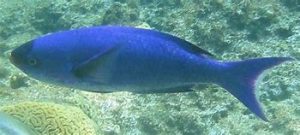
Creole Wrasse
The Creole Wrasse, scientific name Clepticus parrae, is a colorful and fascinating fish found in the tropical waters of the Caribbean Sea and the western Atlantic Ocean. Here are some interesting facts about the Creole Wrasse:
Appearance: Creole Wrasse are known for their vibrant and striking coloration. They have a deep and elongated body with a sloping forehead. Their bodies can vary in color depending on their gender and maturity. Adult males have a predominately blueish body with a yellowish stripe that extends from the snout to the base of the tail. It changes color markedly during its lifetime, with juveniles being almost completely violet-purple.
Social Structure: Creole Wrasse are social fish that typically form large schools consisting of both males and females. These schools can include hundreds or even thousands of individuals. The social structure within the school is hierarchical, with dominant males occupying the top positions and actively defending their territories.
Reproduction: Creole Wrasse undergo a unique reproductive process known as “sequential hermaphroditism.” They are initially born as females and may transition to males later in life. When a dominant male dies or is removed from the school, the largest female undergoes a sex change to become the new dominant male. This sex change allows for the continuous maintenance of a reproductive hierarchy within the school.
Feeding Habits: Creole Wrasse are carnivorous and primarily feed on small invertebrates such as crustaceans, worms, and small mollusks. They are active foragers and use their protractile mouths to snatch prey from the water column or pick them off the substrate. As part of their feeding behavior, they may also visit cleaning stations where cleaner fish remove parasites and dead skin from their bodies.
Habitat and Distribution: Creole Wrasse are typically found in reef environments, including coral reefs, rocky reefs, and seagrass beds. They prefer areas with moderate to strong currents. Their distribution ranges from the western Atlantic Ocean, including the Caribbean Sea, to the northern coast of South America.
Conservation Status: The Creole Wrasse is not currently listed as a threatened species. However, like many reef-associated fish species, they face potential threats from habitat degradation, overfishing, and the impacts of climate change. It is important to monitor their populations and protect their reef habitats to ensure their long-term survival.